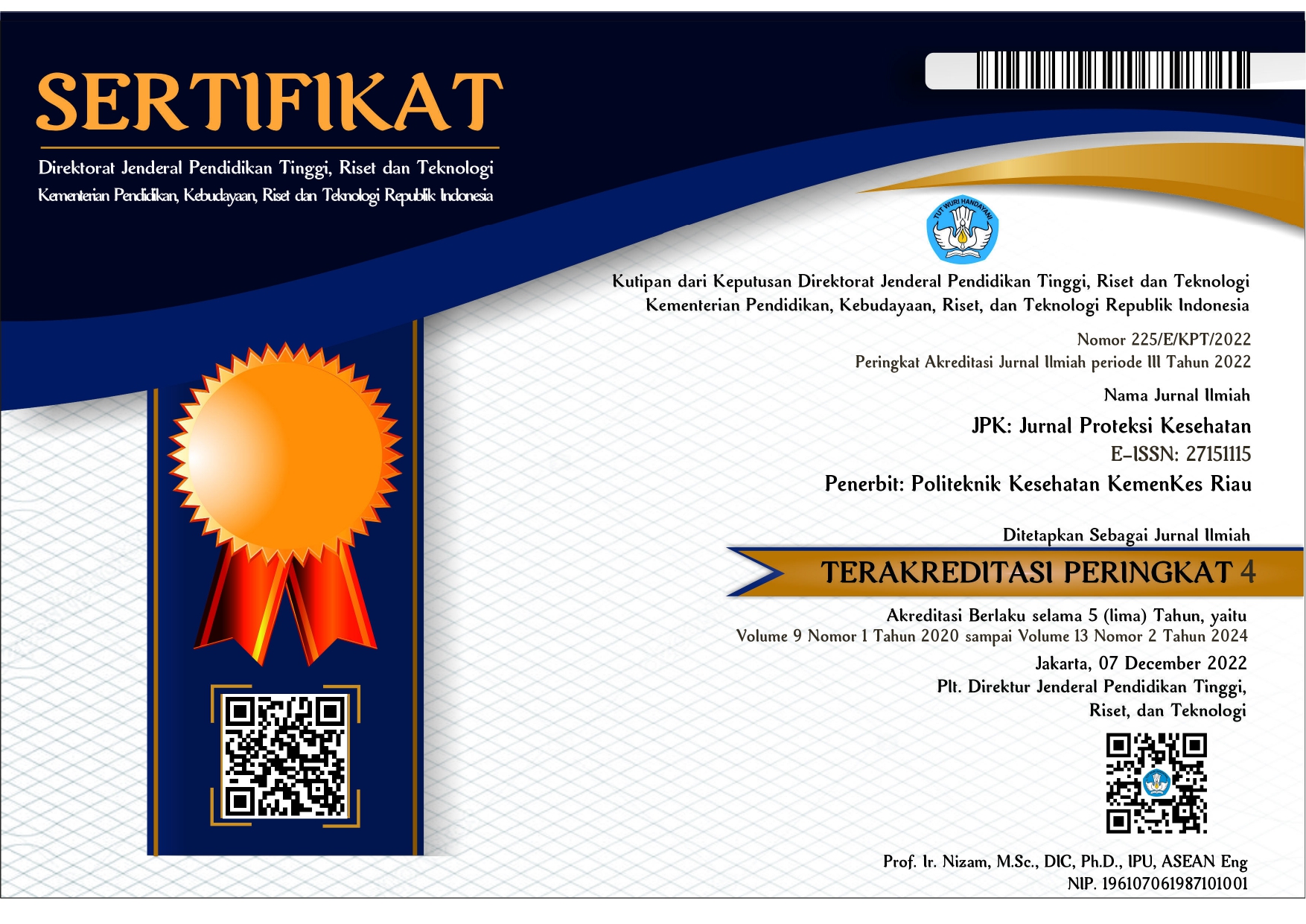Formulation and Characterization of Nanoemulsion Turmeric oil
Abstract
Turmeric oil is an essential oil derived from turmeric (Curcuma domestica). Turmeric oil is known to have antiinflammatory, antibacterial, antifungal and antioxidant activities. Nanoemulsions have the advantage of improving drug absorption and bioavailability. The purpose of the formulation of this nanoemulsion is to know the characteristics of turmeric oil nanomulsions. The formula consists of F1 (5%), F2 (10%), and F3 (15%). The preparation assessment covers organoleptic, pH, viscosity, stability, particle size, and zeta potential. The nanoemulsion preparation is produced in a thick yellow, typical odor of turmeric oil, with a pH of 6.8-7, a viskosity of 23-29 Cps, transmission values of 43.3-74.6%, droplet sizes at F1, F2, F3 of 23.2 nm, 203.8 nm, and 298.7 nm and zeta values potentials F1, F2 - 18.5mV, F 2 - 13.4mv, and F3 -8,5mV, all of the formulas well physically stable by the cracking, sedimentation and tubidity.
References
P. A. Anindita et al., “Dataset of Agromorphological Traits in Early Population of Turmeric (Curcuma longa L.) Local Accessions from Indonesia,” Data Brief, vol. 33, p. 106552, 2020, doi: 10.1016/j.dib.2020.106552.
R. Hosdurga, R. S.N, M. N, Prathima. K. Shetty, R. .P, and R. Chandrashekar, “Phytochemical Analysis of Methanolic Extract of Curcuma Longa Linn,” International Journal of Universal Pharmacy and Biosciences 2319-8141, vol. 2, pp. 39–45, Mar. 2013.
A. M. Orellana-Paucar and M. G. Machado-Orellana, “Pharmacological Profile, Bioactivities, and Safety of Turmeric Oil,” Molecules, vol. 27, no. 16, pp. 1–16, 2022, doi: 10.3390/molecules27165055.
K.-H. Lee et al., “Essential Oil of Curcuma longa Inhibits Streptococcus mutans Biofilm Formation,” J Food Sci, vol. 76, pp. H226-30, Sep. 2011, doi: 10.1111/j.1750-3841.2011.02427.x.
S. Yadav, A. K. Sah, R. Jha, P. Sah, and D. Shah, “Turmeric (curcumin) Remedies Gastroprotective Action,” Pharmacogn Rev, vol. 7, no. 13, pp. 42–46, 2013, doi: 10.4103/0973-7847.112843.
C. A. C. Araújo and L. L. Leon, “Biological Activities of Curcuma longa L,” Mem Inst Oswaldo Cruz, vol. 96, no. 5, pp. 723–728, 2001, doi: 10.1590/S0074-02762001000500026.
R. Urban-Chmiel et al., “Antibiotic Resistance in Bacteria—A Review,” Antibiotics, vol. 11, no. 8. MDPI, Aug. 01, 2022. doi: 10.3390/antibiotics11081079.
R. J. Wilson, Y. Li, G. Yang, and C.-X. Zhao, “Nanoemulsions for Rrug Delivery,” Particuology, vol. 64, pp. 85–97, 2022, doi: https://doi.org/10.1016/j.partic.2021.05.009.
R. Kumar, G. Soni, and S. K. Prajapati, “Formulation Development and Evaluation of Telmisartan Nanoemulsion,” International Journal of Research and Development in Pharmacy & Life Sciences, vol. 06, pp. 2711–2719, Sep. 2017, doi: 10.21276/IJRDPL.2278-0238.2017.6(4).2711-2719.
R. Kumar Harwansh et al., “Nanoemulsions as Vehicles for Transdermal Delivery of Glycyrrhizin,” Brazilian Journal of Pharmaceutical Sciences. vol. 47, n. 4, oct./dec., 2011 2011.
D. S. Shaker, R. A. H. Ishak, A. Ghoneim, and M. A. Elhuoni, “Nanoemulsion: A Review on Mechanisms for the Transdermal Delivery of Hydrophobic and Hydrophilic Drugs,” Sci Pharm, vol. 87, no. 3, 2019, doi: 10.3390/scipharm87030017.
B. Eko Prasetyo, H. Adela, and W. Wiladatika, “Formulation and Characterization of Nanoemulsion of Tread leave Ethanol Extract (Catharanthus roseus (L.) G. Don) as Antihyperglycemic,” Indonesian Journal of Pharmaceutical and Clinical Research (IDJPCR), vol. 02, no. 2, 2019.
P. A. Anindita et al., “Dataset of Agromorphological Traits in Early Population of Turmeric (Curcuma longa L.) Local Accessions from Indonesia,” Data Brief, vol. 33, p. 106552, 2020, doi: 10.1016/j.dib.2020.106552.
R. Hosdurga, R. S.N, M. N, Prathima. K. Shetty, R. .P, and R. Chandrashekar, “Phytochemical Analysis of Methanolic Extract of Curcuma Longa Linn,” International Journal of Universal Pharmacy and Biosciences 2319-8141, vol. 2, pp. 39–45, Mar. 2013.
A. M. Orellana-Paucar and M. G. Machado-Orellana, “Pharmacological Profile, Bioactivities, and Safety of Turmeric Oil,” Molecules, vol. 27, no. 16, pp. 1–16, 2022, doi: 10.3390/molecules27165055.
K.-H. Lee et al., “Essential Oil of Curcuma longa Inhibits Streptococcus mutans Biofilm Formation,” J Food Sci, vol. 76, pp. H226-30, Sep. 2011, doi: 10.1111/j.1750-3841.2011.02427.x.
S. Yadav, A. K. Sah, R. Jha, P. Sah, and D. Shah, “Turmeric (curcumin) Remedies Gastroprotective Action,” Pharmacogn Rev, vol. 7, no. 13, pp. 42–46, 2013, doi: 10.4103/0973-7847.112843.
C. A. C. Araújo and L. L. Leon, “Biological Activities of Curcuma longa L,” Mem Inst Oswaldo Cruz, vol. 96, no. 5, pp. 723–728, 2001, doi: 10.1590/S0074-02762001000500026.
R. Urban-Chmiel et al., “Antibiotic Resistance in Bacteria—A Review,” Antibiotics, vol. 11, no. 8. MDPI, Aug. 01, 2022. doi: 10.3390/antibiotics11081079.
R. J. Wilson, Y. Li, G. Yang, and C.-X. Zhao, “Nanoemulsions for Rrug Delivery,” Particuology, vol. 64, pp. 85–97, 2022, doi: https://doi.org/10.1016/j.partic.2021.05.009.
R. Kumar, G. Soni, and S. K. Prajapati, “Formulation Development and Evaluation of Telmisartan Nanoemulsion,” International Journal of Research and Development in Pharmacy & Life Sciences, vol. 06, pp. 2711–2719, Sep. 2017, doi: 10.21276/IJRDPL.2278-0238.2017.6(4).2711-2719.
R. Kumar Harwansh et al., “Nanoemulsions as Vehicles for Transdermal Delivery of Glycyrrhizin,” Brazilian Journal of Pharmaceutical Sciences. vol. 47, n. 4, oct./dec., 2011 2011.
D. S. Shaker, R. A. H. Ishak, A. Ghoneim, and M. A. Elhuoni, “Nanoemulsion: A Review on Mechanisms for the Transdermal Delivery of Hydrophobic and Hydrophilic Drugs,” Sci Pharm, vol. 87, no. 3, 2019, doi: 10.3390/scipharm87030017.
B. Eko Prasetyo, H. Adela, and W. Wiladatika, “Formulation and Characterization of Nanoemulsion of Tread leave Ethanol Extract (Catharanthus roseus (L.) G. Don) as Antihyperglycemic,” Indonesian Journal of Pharmaceutical and Clinical Research (IDJPCR), vol. 02, no. 2, 2019.
Elya Zulfa, Danang Novianto, and Dedy Setiawan, “Formulasi Nanoemulsi Natrium Diklofenak dengan Variasi Kombinasi Tween 80 dan Span 80: Kajian Karakteristik Fisik Sediaan,” vol. 14, 2019.
Y. Sri Wahyuni, R. Melinda, A. Arinia Rasyad, S. Tinggi Ilmu Farmasi Bhakti Pertiwi Palembang, and S. Selatan, “JPS) |Volume 5| No. 2 |JULI-DES|2022|pp,” Journal of Pharmaceutical and Sciences, pp. 409–416, 2022.
S. E. Priani, A. F. Halim, S. P. Fitrianingsih, and L. Syafnir, “Uji Aktivitas Inhibitor Tirosinase Ekstrak Kulit Buah Cokelat (Theobroma cacao L.) dan Formulasinya dalam Bentuk Sediaan Nanoemulsi,” Jurnal Sains Farmasi & Klinis, vol. 8, no. 1, p. 1, Apr. 2021, doi: 10.25077/jsfk.8.1.1-8.2021.
T. Indrawati, T. Siregar, Kartikasari “Optimize Anti-Inflamatory Effectivities of Extract Galanga L. in Oinment”. Archives of Pharmacy Practice. Vol. 3, Issue 1, 2012
S. H. Yuliani, M. Hartini, B. Pudyastuti, and E. Perdana Istyastono, “Comparison Of Physical Stability Properties Of Pomegranate Seed Oil Nanoemulsion Dosage Forms With Long-Chain Triglyceride And Medium-Chain Triglyceride As The Oil Phase,” Traditional Medicine Journal, vol. 21, no. 2, 2016.
K. Sari, P. Studi Fisika, J. Mipa, and U. Jenderal Soedirman Purwokerto, “Pengaruh Konsentrasi Larutan Ekstrak Daun Lidah Mertua Terhadap Absorbansi dan Tranmitansi Pada Lapisan Tipis,” Seminar Nasional Fisika. 2012.
A. Gupta, H. B. Eral, T. A. Hatton, and P. S. Doyle, “Nanoemulsions: Formation, properties and applications,” Soft Matter, vol. 12, no. 11. Royal Society of Chemistry, pp. 2826–2841, 2016. doi: 10.1039/c5sm02958a.
G. Ulima Nibras and T. Alawiyah, “Formulation and Evaluation of Nanomouthwash Turmeric Rhizome Extract (Curcuma domestica Val.) As A Ulceration Treatment,” FARMASIS: Jurnal Sains Farmasi, vol. 3, no. 2, 2022.
A. Catur Adi, N. Setiawaty, A. Larasati Anindya, and H. Rachmawati, “The Creative Commons Attribution-NonCommercial-ShareAlike license (CC BY-NC-SA 4.0). Formulation and Characterization of Vitamin A Nanoemulsion,” Media Gizi Indonesia. 2019, vol. 14, no. 1, pp. 1–13, doi: 10.204736/mgi.v14i1.1-13.
L. Gao, D. Zhang, and M. Chen, “Drug Nanocrystals for the Formulation of Poorly Soluble Drugs and its Application as a Potential Drug Delivery System,” Journal of Nanoparticle Research, vol. 10, no. 5. pp. 845–862, May 2008. doi: 10.1007/s11051-008-9357-4.
F. S. Handayani, B. H. Nugroho, and S. Z. Munawiroh, “Optimization of Low Energy Nanoemulsion of Grape Seed Oil Formulation using D-Optimal Mixture Design (DMD),” Jurnal Ilmiah Farmasi, vol. 14, no. 1, pp. 17–34, 2018, [Online]. Available: http://journal.uii.ac.id/index.php/JIF












